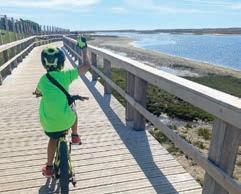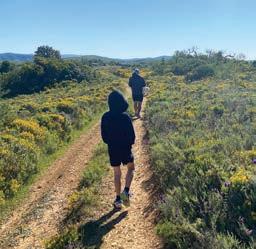
7 minute read
Travel - My Qatar
You couldn’t pay me enough to leave the cage. But the sharks seem more curious than crazed. This isn’t hectic – it feels wild, exhilarating, joyous even. I barely stop babbling when we resurface.
Why dive with great whites? For the adrenaline, obviously, and also for the adventure. Certified divers among the 12 passengers on the Princess II, our comfortable liveaboard boat with double and triple en-suite cabins, describe this three-night expedition as the trip of a lifetime.
Advertisement
Many also cite the company’s ethics as a reason to come. In an industry which has earned the disapprobation of marine biologists for excessive chumming with meat, Rodney Fox Shark Expeditions scores a gold star for conservation. Nor is there any of the ‘crash and bash’ of sharks into cages that some operators encourage. “No one thinks it’s OK to poke a lion with a stick through the bars,” Andrew says. “We have a responsibility not to make this a circus act.”
On our first night on board he presents shark photos like family snapshots. This is Kerry. Here’s Big Ali – “she’s a lovely shark, really smiley”. Here’s Big Moo and Cuddles – “I’m not making this up: that really was its name”.
Every night, while the rest of us chow down dinner, Andrew pores over the day’s photos to identify old friends and new arrivals for a scientific database.. We’re all shark-huggers on this boat, one crew member tells me. Yet I can’t help but wonder whether there’s an unspoken element of fear too. Maybe secretly that’s why we’re all here.
No animal twangs our atavistic nerves like the great white shark. We fenced off or caged up land predators a while ago. It’s only great whites that can’t be tamed. They are a relic from the age of dinosaurs that confront us with what Jaws author Peter Benchley called “the visceral fear of being eaten”.
Just as that’s part of the mystique of shark diving, it’s what helped make Stephen Spielberg’s Jaws a blockbuster. So powerful was Spielberg’s film four decades ago it has made galeophobia – an irrational fear of sharks – the norm. Because of Jaws every shark fatality is global news even though more people are killed each year by bees. Because of Jaws no English word elicits so strong a reaction as ‘shark’. So it seems ironic that the planet’s greatest shark-hugger is partly to blame.
With Australian film-makers Ron and Valerie Taylor, Rodney Fox, Andrew’s father, shot the live footage for Jaws at the Neptune Islands in 1973.
A decade earlier he had been an insurance salesman. Then the worst shark attack in Australian history changed everything. “I thought I’d been
hit by a train,” Rodney recalls of the great white that smashed into his side while he was spear-fishing near Adelaide in 1963. “My chest was clamped, like in a vice. I was a bone in a dog’s mouth.” His survival was a minor miracle. It took 462 stitches to patch up his shattered ribs, collapsed lung, ruptured spleen and deep lacerations which arced from his shoulder to his waist. One tooth remains embedded in his wrist. Yet perhaps the most astonishing element of Rodney’s story is what happened next.
To conquer his fear, he began to study great whites at a time when most people thought the only good shark was a dead one. Inspired by a trip to Adelaide zoo, he invented cage diving. Soon documentary makers and scientists arrived at his suburban Adelaide home. “It was like having a lot of astronauts at your house,” Andrew recalls. More people had gone into space than had swum with great whites.
Then in 1973 Spielberg picked up the phone. There were no giant rubber sharks during filming at the Neptunes. These great whites were almost as dangerous as that in the screenplay. For one scene Rodney narrowly dodged snapping teeth to draw ‘bullet holes’ on to a large shark’s snout with lipstick. Another 4m great white became caught in the cage and nearly sank the 6m boat that stood-in for the Orca. In Peter Scheider’s famous improvised line, they really did need a bigger boat.
Benchley came to regret how Jaws demonised an apex predator of the marine ecosystem. He would’ve been the fiercest critic of a shark cull by the West Australian government last year. Launched after seven human fatalities over three years, it was Jaws redux. Rodney agrees: “After so much research about how sharks aren’t these savage biting machines but do a great job of
maintaining the balance of the oceans and how we’re the ones who are messing it up you had intelligent people doing the cowboy stuff and killing for the sake of killing.” Except that this time there was a public backlash.
It strikes me on the Princess II that seeing sharks first-hand in the wild may be the best conservation message there is. I enjoy the descent of my last dive; the sense of vast empty space as we drop underwater, the silence except for the rumble and hiss of my breathing through the regulator. Again, the great whites circle the cage, watching us watching them. There’s IMAX with his kinked tail and there’s Bubbles with his bloated belly. I’ve become a sharkhugger. This time, however, I’m struck by the sharks’ brilliant hydrodynamics; by their streamlined bodies that swoop along a lateral line then flatten at the tail. And look at the colours: gun-metal grey, burnished steel, a dark bronze sheen.
It feels a privilege to hang here above the kelp and witness such a powerful, perfectly evolved predator in its own environment. It has a strange, aweinspiring beauty. If only Spielberg had included that in Jaws too.
I’m lucky to live an outdoor lifestyle all year round. Being a foodie I try to keep some balance with boxing, paddle tennis, hiking in the Loulé hills, barre and cold water sea swimming. I love the new boardwalk at Quinta do Lago; it’s kilometres long and is ideal for my power walks or cycling with my kids to Faro island, whilst the planes land overhead.
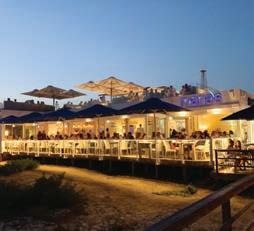
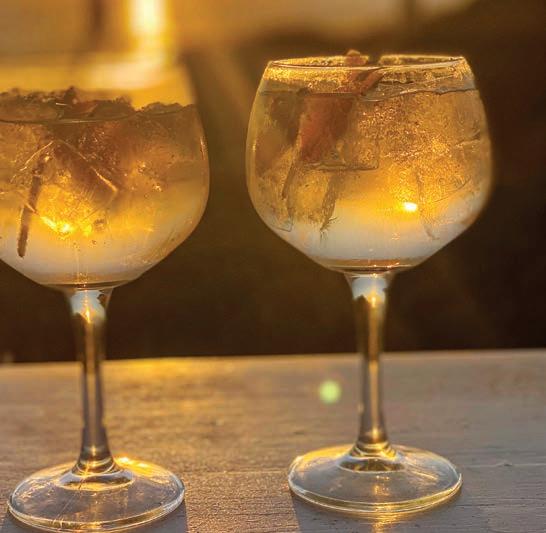
My Loulé
Harriet Campina of Maria’s Beach Restaurant. Spreading the Algarve love @portu_girl

Ihave been visiting this area since I was a teen. Having studied languages at university and living abroad before it seemed like fate when I met my Portuguese husband 15 years ago in my favourite – and his family’s – restaurant, Alambique. Three years later I moved here from London and we now have three children between us. For me it is the perfect place to raise a family.
I have learnt the language, embraced local Portuguese life and found my tribe within a wonderful expat community. More people are now living here full time so new schools, facilities and restaurants are opening to accommodate the boom. The region is large, spreading over beaches and hills. There is so much to do and see! I love to share tips and new finds on my Instagram.
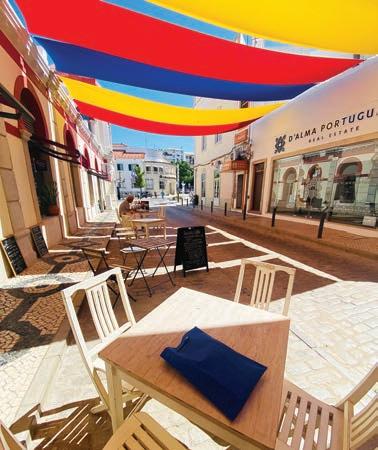
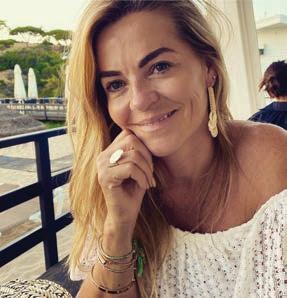
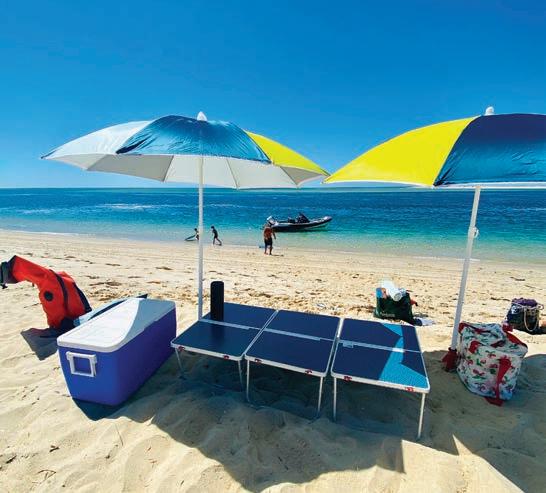
Our summer season is hectic so for family time we love to escape to the nearby Ria Formosa islands. Surrounded by lagoons and calm, clear waters we picnic or eat with our feet in the sand at Camaleão (Armona).
I love organising evening beach picnics with friends down by 3 Moço bar; the adults and children play cricket and we swim until dark. Simple pleasures.
Algarve sunsets are special and best enjoyed at Maria’s where you can drink cocktails and dine with an ocean view. The rooftop bar is open in warm months with great music. Bamboo Restaurant is also a fun destination – owned by my husband’s family – serving Asian fusion and sushi and a DJ every night.
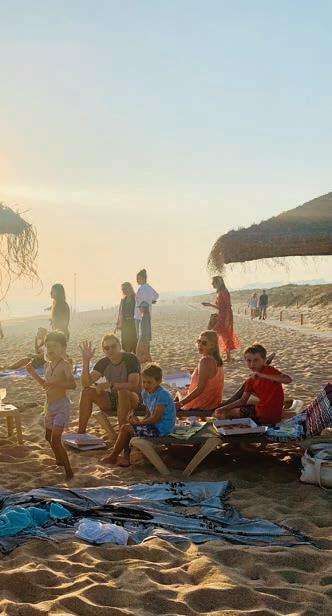
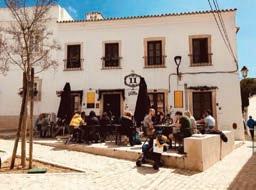
Loulé is a busy and authentically Portuguese town with charming medieval cobbled back streets, a beautiful castle and a popular market. There is a vibrant energy with new bars, restaurants and cafes. We are spoiled for choice but I love 11 da Villa for tapas, Café Zique for rooftop dinners, Pirá for ceviche. In lockdown our highlight was piri piri take-outs from Jolibela. My favourite coffee house is Bean17.
